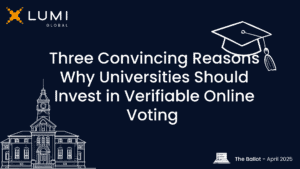Online voting can be a promising means of enticing more voters to engage in democratic processes, in particular due to its accessible nature and flexibility in a wide variety of circumstances, environments, and vote types. In spite of its adaptable and usable nature, it is also not unheard of for organizations and voters alike to still prefer to use more “traditional” methods of voting, in particular paper ballots. But, as the old saying goes, “why not both?” It is in fact possible to use online voting in tandem with other ways of voting, what we term “hybrid voting,” and in this piece we would like to explore what the phrase encompasses, how it happens in practice, and what is important to have in mind when using hybrid voting.
1. What is "Hybrid Voting?"
As we mentioned above, we define “hybrid voting” as a type of voting which makes use of both online voting and paper balloting. Online voting may seem like a new addition to elections, but it is in fact an example of what is called “convenience voting,” meaning “any mode of balloting other than precinct-place voting.” These include not only online voting, but also voting in-person early, voting by mail, and even voting by fax (yes, faxing is still around). The goal of convenience voting is, as its name implies, to make voting more convenient for voters by allowing them to vote whenever or wherever suits them best.
Hybrid voting is thus, in essence, about making voting easier by letting voters choose to cast their ballots in a manner which best suits them. For an organization with a national or international footprint, members residing in its home country may prefer casting paper ballots, while members living further away would rather be able to cast their ballots remotely. The same can be said for organizations with members with disabilities, as they may need convenience voting methods (such as online voting) to vote comfortably. The point remains the same: voters have the ability to choose whichever method best suits them with hybrid voting.
2. How do organizations use hybrid voting?
Convenience voting is nothing new, as voters in places such as Australia have enjoyed postal voting since 1906 as a means of overcoming challenges presented by distance from polling stations. This still rings true today as hybrid voting has become possible, with nearly all states in the United States offering all citizens, regardless of circumstance, the chance to vote by mail and a further 26 states (along with Washington DC and the US Virgin Islands) allowing at least some of their voters to submit a ballot electronically, either via email or online portal, if they are too far from a polling station, in particular if they live overseas or are in the military.
We have also experienced how hybrid voting can work on a smaller scale, such as in the Senior Citizens’ Council of Copenhagen which used hybrid voting in its most recent election in 2020. Although the percentage of voters voting digitally has doubled since 2016, it is still possible for voters to vote using a method with which they may be more comfortable – paper ballots – and thus ensure no voter is left behind. Seeing as how online voters tend to become demographically similar to paper voters over time, using hybrid voting in smaller organizations can also help those less familiar with technology become more comfortable with it over time, perhaps even leading to fully online elections.
3. What can hybrid voting do?
Up to now, we have defined hybrid voting and given some examples of what it looks like in practice. But what can using it actually do for an organization? We offer four key benefits below.
• Ensure that all eligible voters can vote
By embracing online voting, remote communities far from population centers can overcome challenges presented by distance and exercise their democratic rights with ease. No matter how distant from cities they may be, residents of remote areas will no longer face the burden of lengthy journeys or reliance on scarce transportation services just to vote.
• Make transitions to larger-scale online voting easier
Voting online, when provided by experienced vendors, can be a seamless experience for voters. However, it is normal to expect some hesitancy when adopting new technologies. Even if your organization may aim to have 100% digital elections, introducing an online voting system while still allowing members to vote via traditional means can help those more reluctant at least see how the technology works while not using it themselves, perhaps leading to a desire to use it down the road.
• Avoid pressuring voters into using new systems/technologies
No matter how attractive it sounds, some members or voters may still not be won over by the idea of voting online. As in any healthy democracy, minority rights must also be respected and, by offering the chance for voters to still cast paper ballots while introducing online voting, no voter will be left behind due to their personal preferences in how they engage with democracy.
• Potentially boost turnout/engagement
Voter participation is a complex issue; there isn’t a “one size fits all”- type solution which can always boost turnout. In spite of this, evidence shows that expanding convenience voting is linked with slightly higher voter turnout in government elections and even higher turnout in organizational elections and votes, as seen in the votes on the Danish Collective Agreements.
Things to consider when pursuing hybrid voting
If it wasn’t clear already, we believe that hybrid voting can be an excellent means of providing choice to voters, boosting their engagement, and making transitions to using online voting much smoother for organizations. However, this does not mean that successfully employing it is always straightforward or that problems will not arise. It is essential to note that, while providing voters with a choice between online and physical ballots is great, preparing both of these things and distributing the former will take time and resources. With good planning and proper budgeting, along with help from an experienced provider, it is possible to prepare both online and physical ballots, but it may be a longer process.
Additionally, should your organization pursue hybrid voting, you would have to make sure to have a method of dealing with scenarios in which a voter submits both an online and a physical ballot. While this can certainly be remedied, such as by only counting paper ballots if a voter votes online and with paper, it will require extra oversight on the election organizers’ part to ensure that voters are not able to successfully vote twice. Fortunately, experienced providers of online voting solutions should be able to help your organization mitigate these concerns by drafting contingency plans before voting begins and offering assistance once voting commences, should the need arise.
Though we discussed it at length in this piece, it is nonetheless important to reiterate a previous point. In an election, it is important that whomever is eligible to vote can vote, regardless of any obstacles they may face, including distance, mobility, technological literacy, and so forth. By offering voters a choice in how they may cast ballots, hybrid voting helps organizations ensure that all eligible voters can cast ballots in the way they choose. From the members who prefer handling physical ballots to members who need to vote online due to distance or physical limitations, hybrid voting ensures that everyone may vote and demonstrates how online voting can be used to supplement, not substitute, existing democratic processes.


